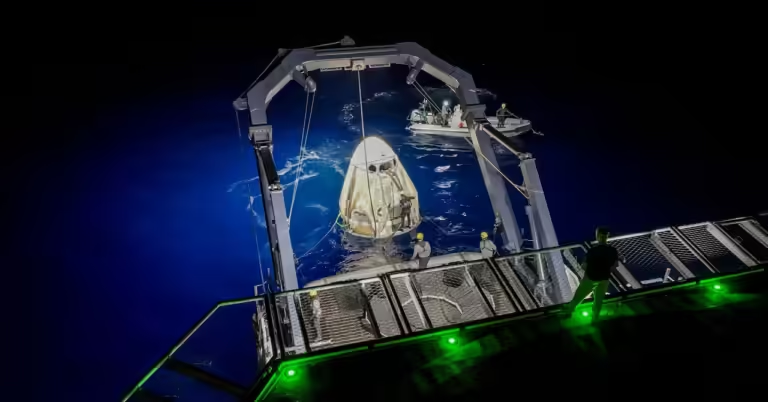A white spacecraft, lightly toasting like a marshmallow and smelling of burnt metal, fell from the night sky early Sunday morning, landing in the Gulf of Mexico not far from Key West.
The dark waters there were carefully chosen from dozens of potential landing sites near Florida because winds and seas were predicted to be particularly calm and gentle during the time the Crew Dragon spacecraft would land. Resilience It floated slowly out to sea, waiting for a recovery boat to arrive.
Aboard the spacecraft were four crew members: Commander Jared Isaacman, the billionaire who had funded the mission and had just completed his second private spaceflight; Sara Gillis and Anna Menon, SpaceX engineers and employees who had flown the company’s first orbital flight; and pilot Kidd Poteet.
They were happy to be home.
“Mission accomplished,” Isaacman said after the spacecraft landed.
Big success
Their mission was arguably the most ambitious private spaceflight ever, and a complete success. The mission, named Polaris Dawn, flew to an altitude of 1,408.1 kilometers on its first day of flight, the highest Earth orbital mission to date and the furthest humans have traveled from Earth since the Apollo missions more than half a century ago.
Photo: SpaceX/Getty Images
Then, on the third day of the flight, the four crew members donned space suits designed and developed over the past two years, and after venting the cabin air into space, first Isaacman and then Gillis stretched out outside the Dragon spacecraft for a few minutes, in the first private spacewalk in history.
Although this foray into space was merely a repeat of the tethered spacewalks conducted by the Soviet Union and then the United States in the mid-1960s, it was still significant. These civilian spacesuits were a fraction of the cost of government spacesuits and could be considered version 1.0 of the spacesuits that will enable many people to walk in space, on the Moon, and eventually Mars in the future.
Finally, on the final day of its mission in space, the Dragon spacecraft demonstrated connectivity with a mesh of Starlink satellites in low orbit. The crew conducted an uninterrupted 40-minute video call with flight operators at SpaceX headquarters in Hawthorne, California. During that time, Dragon fired the spacecraft’s Draco thrusters 16 times and maintained communications with the Starlink satellites via laser link, according to the company.
The test demonstrated the feasibility of using thousands of Starlink satellites in orbit as a means of providing high-speed internet to people and spacecraft in space.
Wait, isn’t this just a billionaire’s game?
Some misunderstood the mission, seeing Isaacman as a financial tech billionaire fulfilling his desire to get into space aboard a manned spacecraft built by Elon Musk’s rocket company, SpaceX, making it seem like nothing more than a rollercoaster ride for the super-rich and famous — people whose thrill-seeking needs can’t be satisfied by Earthly pleasures.
I understand this view but I don’t agree with it.

